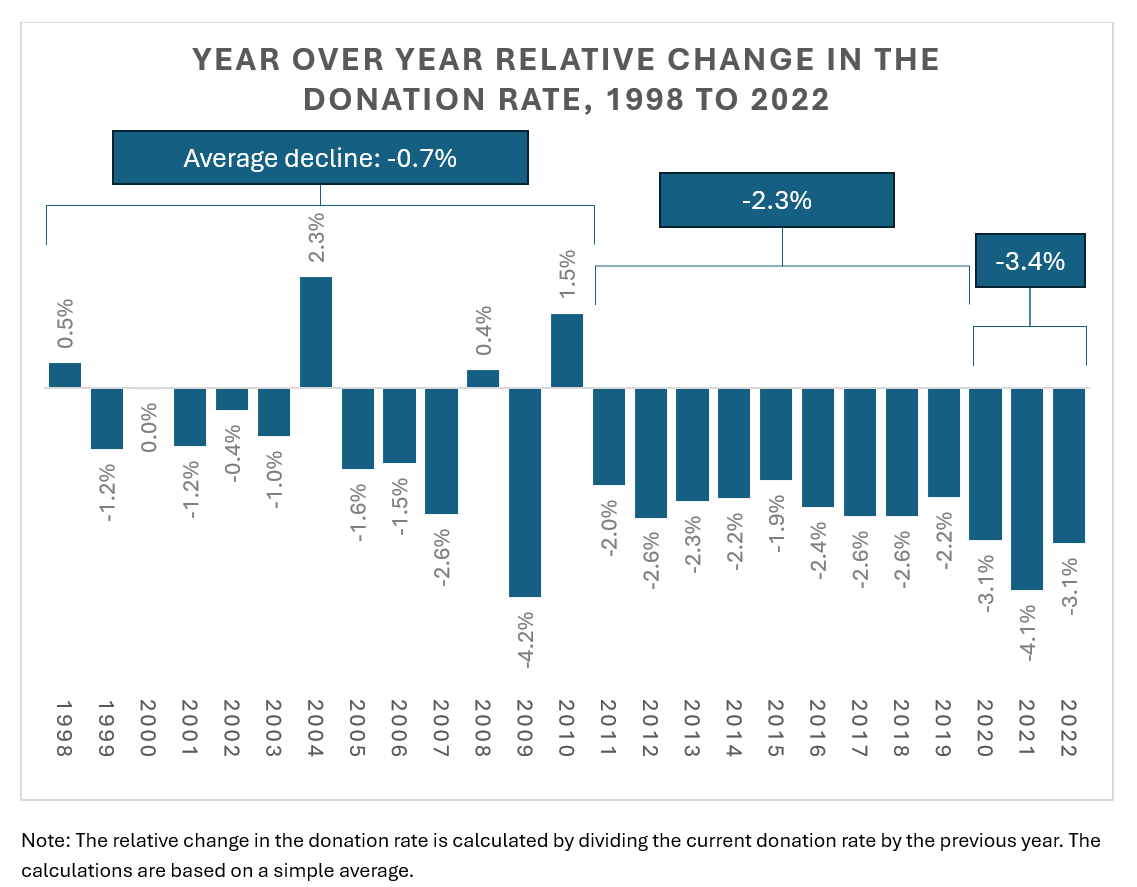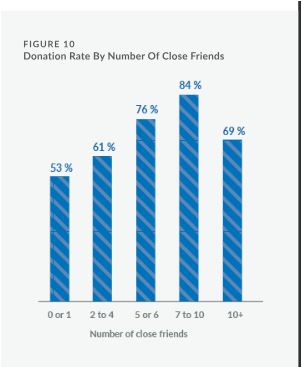- Home
- About Us
- The Team / Contact Us
- Books and Resources
- Privacy Policy
- Nonprofit Employer of Choice Award

For the 12th year straight, tax filer data reveals that the percentage of Canadians claiming charitable donations has declined again. This year, the downward trend continues, with only 17.1% of Canadian tax filers claiming charitable donations, down from 17.7% last year and significantly lower than the 20.0% figure from five years ago.

The difference is even more striking compared to 1997, the year our dataset started, when 25.7% of Canadians claimed charitable donations. Despite the number of tax filers growing by 8.4 million from 1997 to 2022 (reaching 28.9 million), the number of Canadians claiming donations on their taxes dropped by more than 300,000 over these 25 years (to just under 5 million).
This ongoing decline has persisted through drastically different economic conditions—whether unemployment was rising or falling, home costs were stable or skyrocketing, and regardless of whether incomes were outpacing inflation or not.
Over the last 25 years, we have seen declining donation rates in 21 years. The last time we had an increase in the donation rate was in 2010.
The trend of declining charitable donations intensified during the pandemic. Three of the four worst years for declining donation rates over the last 25 years occurred since the onset of the pandemic in 2020.

Comparatively, the average annual decline in donation rates during the three pandemic years (2020 to 2022) was -3.4%. This is a significant increase from the average annual decline of -2.3% observed from 2011 to 2019 and markedly higher than the slight average annual decline of -0.7% from 1997 to 2010.
The persistence of this decline—and its acceleration—speaks to the need for real changes in our behaviour at a fundraising level, at a sectoral level, and at a policy level.
The strategies and tactics that have gotten us to this point will not get us anywhere different.
The decline in the donation rate likely costs charities $3 billion a year
The cumulative impact of declining donation rates becomes stark when we consider its long-term effects.
In 2022, the charitable sector had about 2.5 million fewer donors than it would have if the donation rate had remained constant since 1997.
It is likely unrealistic to expect that those who have stopped donating could contribute at the average donation level; in 2022, the average donation exceeded $2,308, with donors tending to be increasingly affluent.
Financial constraints are undoubtedly a factor in this decline, even though donations have decreased across all economic conditions over the past twelve years.
Assuming the 2.5 million donors we have lost could contribute at half the average rate, or $1,154 each, translates to a loss of $2.9 billion in donations annually—underscoring the significant economic challenge the charitable sector faces due to the decline in donors.
It also speaks to the potential opportunity of reversing the trend and the profound consequences the sector will face if we go through another decade or more at the rate of decline that we are now seeing.
The value of donations has continued to do well despite the decline in donors
Despite our major concerns regarding donor rates, it is also crucial to put this issue into perspective.
Despite the decline in donor numbers, and despite a decline in donations of almost $400 million between 2021 and 2022, the total value of donations in 2022 was still more than 19% higher than five years ago (which is a slightly bigger increase than inflation).
The total value of donations was much higher in 2022 than in 2016, even after factoring in decreases in donations in 2022. Increases in the value of donations were mostly due to the increasing donations of major donors.
This influx of large donations has averted sharp declines in donations, yet it also signals a shift towards increased dependence on a smaller number of wealthy donors. These donors are probably less likely to support local community organizations, and their priorities may not align with those of the general population.
Why are donations declining?
The CanadaHelps 2024 Giving Report (Disclosure: I wrote and led the research for this report, though all opinions expressed here are my own) highlights many explanations pointing to why charitable donations are declining:
• increasing financial challenges,
• declining religious attendance, and
• much lower giving by younger generations (likely tied to financial challenges).
The issue with these is explanations is a lack of obvious solutions as to how we can positively influence these factors.
However, the report also points to a broader trend that is playing a critical role in declining donations: people are increasingly disconnected. (Image Source: CanadaHelps. The Giving Report 2024)
 In Canada, according to the 2023 Vital Signs report by Community Foundations of Canada (Disclosure: I was a co-author of this report, though all opinions here are my own), the percentage of people reporting six or more close friends declined from 37% to 22% from 2013 to 2022, while fewer people report knowing “many or most” of their neighbours. Fewer people participate in clubs, and people reported they were less close to their families.1
In Canada, according to the 2023 Vital Signs report by Community Foundations of Canada (Disclosure: I was a co-author of this report, though all opinions here are my own), the percentage of people reporting six or more close friends declined from 37% to 22% from 2013 to 2022, while fewer people report knowing “many or most” of their neighbours. Fewer people participate in clubs, and people reported they were less close to their families.1
Other studies suggest that people started to spend increased time alone in the early 2010s, which continued to surge further during the pandemic as broadband internet and smartphones became increasingly widespread and the pandemic forced us all indoors.
People have replaced time with friends and spend more time at home alone.
The survey of donors shared in the Giving Report 2024, found that people with many close friends are more than 30% more likely to donate (84% of people with 7 to 10 close friends donated versus only 53% of those with 0 or 1 close friends).
The numerous positive associations of having more close friends make pinpointing the underlying mechanics of their role in increasing donations difficult: people with more close friends had more hope for the future and more confidence in charity leaders. They were also more likely to volunteer and participate in community events.
For donations to things like the environment, the power of hope was stunning (though probably tied to political partisanship). Over 18% of those who were very hopeful for Canada's future donated to environmental charities, compared to only 1% of those who were very hopeless.
Reversing the decline
The direction of causality is certainly in question, but the broader point, and its implications, are becoming increasingly clear and cannot be ignored.
Envision two diverging paths that our society might take, shaped by our collective commitment (or lack thereof) to community and charity.
The choice before us is stark but clear.
We must decide whether to invest in, and cultivate, a society that values deep connections and active participation or one willing to risk this continued path to gradual disconnection from the communal ties that enrich our lives. It's a call to action for every individual, every leader, every policy-maker to rekindle the communal bonds that foster a thriving, charitable society.
1 See either the CanadaHelps report or the CFC report for more notes on challenges in comparing these two data sets as their methodologies differ.
Steven Ayer is the President and Founder of Common Good Strategies, where he spearheads transformative research and innovative strategies to strengthen the social sector. An acclaimed author, some of his notable works include "The Burden of Care," highlighting low job satisfaction among nonprofit workers; "Wake-Up Call, detailing 10 shifts in the nonprofit sector post-pandemic)" and "Trust and Impact,” a groundbreaking report on the move towards trust-based philanthropy and unrestricted funding. Each report has been recognized among the top 10 nonprofit sector reports by PANL Perspectives at Carleton University. His research has been mentioned in more than 1000 publications worldwide.